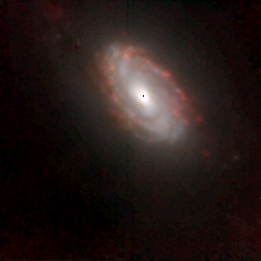| NGC 23 | |
|---|---|
 NGC 23 imaged by the Hubble Space Telescope | |
| Observation data (J2000 epoch) | |
| Constellation | Pegasus |
| Right ascension | 00h 09m 53.411s [1] |
| Declination | +25° 55′ 25.46″ [1] |
| Redshift | 0.015054 [2] |
| Heliocentric radial velocity | 4,568 km/s [3] |
| Distance | 173.5 Mly (53.21 Mpc) [3] |
| Group or cluster | NGC 23 Group (LGG 2) |
| Apparent magnitude (V) | 11.9 mag |
| Absolute magnitude (V) | -21.85 |
| Characteristics | |
| Type | SBb [4] |
| Apparent size (V) | 2.1′ × 1.3′ [2] |
| Other designations | |
| UGC 89, Mrk 545, PGC 698, GC 9. [2] [5] | |
NGC 23 is a spiral galaxy located in the northern constellation of Pegasus, around 173.5 megalight-years distant from the Milky Way. [3] It was discovered by William Herschel on 10 September 1784. [6] [7] In the Webb Society Deep-Sky Observer's Handbook, [8] the visual appearance of NGC 23 is described as follows:
Contents
Bright, extended ellipse; a bright nuclear structure is noticeably elongated; two weak spiral enhancements emerge from opposite sides of the nucleus, one curving towards a bright star attached on the south end. The galaxy is likely interacting with NGC 9.
The shape of this galaxy is described by its morphological classification of SBb, which indicates it is a barred spiral (SB) with spiral arms that are moderately tightly wound (b). [4] It is a luminous infrared galaxy with star-forming clumps. [9]